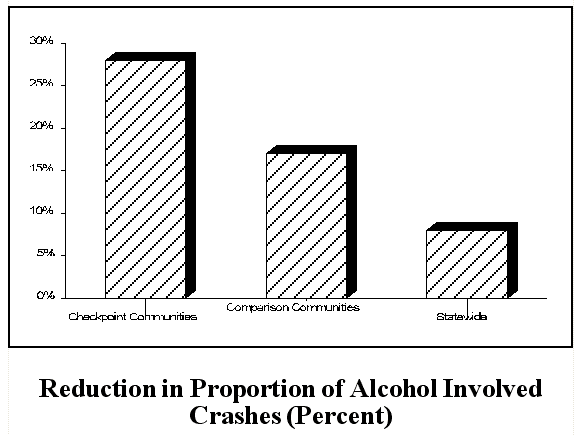















Traffic Tech #103: Field Test Examines Staffing Levels and Mobility in Sobriety Checkpoints |
|---|
|

Number 103 August 1995
FIELD TEST EXAMINES STAFFING LEVELS AND MOBILITY IN SOBRIETY CHECKPOINTS
After the Supreme Court upheld the use of sobriety checkpoints as a Driving While Intoxicated (DWI) countermeasure in 1990, checkpoints have been used with increasing frequency. Evaluations of sobriety checkpoint programs show that they are effective in reducing impaired driving. The National Highway Traffic Safety Administration (NHTSA) has actively supported their use as a DWI deterrent since the mid 1980s.
NHTSA sponsored a study with the support of the California Office of Traffic Safety to gather information about two key checkpoint program decisions: checkpoint staffing and checkpoint site movements or mobility. While the choice of configuration directly influences the cost and effectiveness of a checkpoint program, there is little available data to assess these differences in reducing alcohol impaired driving. Would checkpoint effectiveness be changed by reducing the staffing level at individual checkpoints, thereby reducing the cost of running them? Would increasing the number of checkpoint sites during an evening increase program effectiveness?
Six communities in California participated in this 9 month study. Four communities conducted sobriety checkpoint programs, one community conducted a roving DWI patrol program (another frequently used DWI countermeasure), and one community served as a comparison site. The communities were mid-sized and were comparable in demographics and alcohol involved crashes.
Each of the checkpoint communities conducted 18 checkpoints during the study period, usually 2 per month on weekend nights. The No Mobility sites set up checkpoints for 4 hours in a single location. The High Mobility sites set up checkpoints in 3 locations, each lasting one hour. Low staffing sites had 3 to 5 officers per checkpoint and high staffing sites had 8 to 12 officers per checkpoint. These variations in staffing and mobility fit with available funding for checkpoint programs. The roving patrol community deployed two officers in a specially marked patrol car on weekends twice per month. Total staffing hours of the roving patrol site matched the hours of the high staffing checkpoint sites.
The participating communities publicized their programs in press conferences, news releases, public service announcements (PSAs), supermarket drop-ins, and poster contests. The publicity programs sought to maximize the overall perception of risk of arrest for DWI and therefore did not reveal the specific locations of checkpoints.

Alcohol-Involved Fatalities and Injuries Reduced 28% in Checkpoint Communities
The proportion of all crashes that involved alcohol declined an average of 28% in the 4 communities that ran sobriety checkpoints. This compares with declines of 17% in the comparison community and 8% in California as a whole. When changes in both alcohol and non alcohol crashes are considered, alcohol crashes declined significantly at the checkpoint communities but did not change significantly at the control site. There were no clear effects of either staffing or mobility among the individual checkpoint programs. The roving patrol site showed a smaller reduction in alcohol involved crashes than the checkpoint sites.
Public Awareness Increased
Survey data show that awareness increased during the study period in all 4 of the checkpoint communities. At the end of the 9 month period, about 80% of the public reported awareness of the sobriety checkpoint programs. There were no measured changes in motorists' perceived risk of being stopped or arrested, or in their self-reports of drinking and driving behavior during the programs. The roving patrol community had a lower level of awareness (30%) at the end of its program.
These findings reaffirm the overall effectiveness of checkpoint programs as a DWI deterrent. Sobriety checkpoints remain effective with reduced staffing levels and can save money. A modest increase in the number of sites, however, does not improve their effectiveness. The comparative effectiveness of roving patrols and checkpoints cannot be conclusively answered from these data, however, the greater reductions in alcohol involved crashes in the checkpoint communities suggest that checkpoints may be more effective.
Limited copies of Experimental Evaluation of Sobriety Checkpoint Programs, (80 pages plus appendices) prepared by Anacapa Sciences, are available from the Office of Program Development and Evaluation, NHTSA, NTS-32, 400 Seventh Street, S.W., Washington, DC 20590, (202) 366-2752, or send a fax to (202) 366-7096. Paul Tremont, Ph.D., was the contract manager for this project.
U.S. Department of Transportation
National Highway
Traffic Safety
Administration
400 Seventh Street, S.W. NTS-33
Washington, DC 20590
Traffic Tech is a publication to disseminate information about traffic safety programs, including evaluations, innovative programs, and new publications. Feel free to copy it as you wish.
If you would like to receive a copy contact:
Linda Cosgrove, Ph.D., Editor,
Evaluation Staff Traffic Safety Programs
(202) 366-2759
